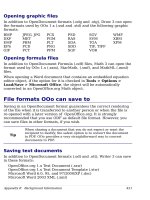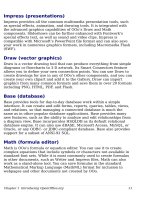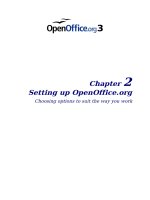Getting Started with Open Office .org 3 part 36 ppsx
Bạn đang xem bản rút gọn của tài liệu. Xem và tải ngay bản đầy đủ của tài liệu tại đây (4.76 MB, 10 trang )
Area options
Area icon: Opens a dialog (Figure 310) with seven tabs: Area,
Shadow, Transparency, Colors, Gradients, Hatching, Bitmaps.
• Area tab: Choose from the predefined list a color, bitmap,
gradient or hatching pattern to fill the selected object.
• Shadow tab: Set the shadow properties of the selected object.
• Transparency tab: Set the transparency properties of the
selected object.
• Colors tab: Modify the available colors or add new ones to appear
on the Area tab.
• Gradients tab: Modify the available gradients or add new ones to
appear on the Area tab.
• Hatching tab: Modify the available hatching patterns or add new
ones to appear on the Area tab.
• Bitmaps tab: Create simple bitmap patterns and import bitmaps,
to make them available on the Area tab.
Area Style / Filling boxes: Select the type of the fill of the selected
object. For more detailed settings, use the Area icon.
Figure 310. Area options dialog
Chapter 11 Graphics, the Gallery, and Fontwork 351
Positioning options
Rotate icon: Rotate the selected object manually using the mouse to
drag the object.
To Foreground icon: Moves the selected object in front of the text.
To Background icon: Moves the selected object behind the text.
Alignment icon: Modifies the alignment of the selected objects.
Bring to front icon: Moves the selected object in front of the others.
Send to back icon: Moves the selected object behind the others.
Change Anchor icon: Switch between anchoring options:
• To Page - The object keeps the same position in relation to the
page margins. It does not move as you add or delete text.
• To Paragraph - The object is associated with a paragraph and
moves with the paragraph. It may be placed in the margin or
another location.
• To Character - The object is associated with a character but is not
in the text sequence. It moves with the paragraph but may be
placed in the margin or another location. This method is similar to
anchoring to a paragraph.
• As Character - The object is placed in the document like any
character and moves with the paragraph as you add or delete text
before the object.
Ungroup icon: Ungroups the selected objects, so you can manage
them individually.
Group icon: Groups the selected objects, so you can manage them as a
single object.
Using menu options
You can use some the choices on the Format menu to anchor, align,
arrange and group selected Fontwork objects, wrap text around them,
and flip them horizontally and vertically.
You can also right-click on a Fontwork object and choose many of the
same options from the pop-up menu. In addition, the pop-up menu
provides quick access to the Line, Area, Text, and Position and Size
dialogs. The Line and Area dialogs are described on pages 350 and
351. The Text dialog offers only a few options for Fontwork objects and
is not discussed here.
352 Getting Started with OpenOffice.org 3
On the Position and Size dialog (Figure 311), you can enter precise
values concerning size and position. For more information, see the
Draw Guide
.
Figure 311. Position and Size dialog
Moving and resizing Fontwork objects
When you select a Fontwork object, eight blue squares (known as
handles
) appear around the edge of the object, as shown below. You
can drag these handles to resize the object.
A yellow dot also appears on the object. This
dot may be along an edge of the object, or it
may be somewhere else; see figure to right
for an example. If you hover the pointer over
this yellow dot, the pointer turns into a hand
symbol. You can drag the dot in different
directions to distort the object.
Hovering the pointer over other parts of the object turns the pointer
into the usual symbol for dragging the object to another part of the
page.
For precise control of the location and size of the object, use the
Position and Size dialog (Figure 311).
Chapter 11 Graphics, the Gallery, and Fontwork 353
Chapter 12
Creating Web Pages
Saving documents as HTML files
Introduction
This chapter describes how to save documents as web pages from
Writer, Calc, Draw and Impress.
Note
Cross references do not become hyperlinks in an HTML
document.
Inserting hyperlinks
When you type text (such as a website addresses or URL) that can be
used as a hyperlink, OOo formats it automatically, creating the
hyperlink and applying to the text a color and underlining. If this does
not happen, you can enable this feature using Tools > AutoCorrect >
Options and selecting URL Recognition.
Tips
If you do not want OOo to convert a specific URL to a hyperlink,
select Edit > Undo Insert from the menu bar or press
Control+Z
immediately after the formatting has been applied.
To change the color of hyperlinks, go to Tools > Options >
OpenOffice.org > Appearance, scroll to
Unvisited links
and/or
Visited links
, pick the new colors and click OK. Caution:
this will change the color for all hyperlinks in all components of
OpenOffice.org—this may not be what you want.
In Writer and Calc (but not Draw or Impress), you can also
change the
Internet link
character style or define and apply
new styles to selected links.
You can also insert and modify links using the Hyperlink dialog
(Figure 312). To display the dialog, click the Hyperlink icon on the
Standard toolbar or select Insert > Hyperlink from the menu bar. To
turn existing text into a link, highlight it before opening the Hyperlink
dialog.
On the left hand side, select one of the four types of hyperlinks:
• Internet: a web address, normally starting with http://
• Mail & News: for example an email address.
• Document: the hyperlink points to another document or to
another place in the presentation.
• New document: the hyperlink creates a new document.
Chapter 12 Creating Web Pages 355
Figure 312. Hyperlink dialog showing details for Internet links
The top right part of the dialog changes according to the choice made
for the hyperlink type. A full description of all the choices, and their
interactions, is beyond the scope of this chapter. Here is a summary of
the most common choices used in presentations.
For an
Internet
type hyperlink, choose the type of hyperlink (choose
between Web, FTP or Telnet), and enter the required web address
(URL).
For a
Mail and News
type hyperlink, specify whether it is a mail or
news link, the receiver address and for email, also the subject.
For a
Document
type hyperlink, specify the document path (the Open
File button opens a file browser); leave this blank if you want to link to
a target in the same presentation. Optionally specify the target in the
document (for example a specific slide). Click on the Target icon to
open the Navigator where you can select the target, or if you know the
name of the target, you can type it into the box.
For a
New Document
type hyperlink, specify whether to edit the newly
created document immediately or just create it (Edit later) and the
type of document to create (text, spreadsheet, etc.). For a presentation,
Edit now is the more likely choice. The Select path button opens a
directory picker.
The
Further settings
section in the bottom right part of the dialog is
common to all the hyperlink types, although some choices are more
relevant to some types of links.
356 Getting Started with OpenOffice.org 3
• Set the value of Frame to determine how the hyperlink will open.
This applies to documents that open in a Web browser.
• Form specifies if the link is to be presented as text or as a button.
• Text specifies the text that will be visible to the user.
• Name is applicable to HTML documents. It specifies text that will
be added as a NAME attribute in the HTML code behind the
hyperlink.
• Event button: this button will be activated to allow OOo to react
to events for which the user has written some code (macro). This
function is not covered in this book.
Editing hyperlinks
To edit an existing link, place the cursor anywhere in the link and click
Edit > Hyperlink. The Hyperlink dialog (Figure 312) opens. Make
your changes and click Apply. If you need to edit several hyperlinks,
you can leave the Hyperlink dialog open until you have edited all of
them. Be sure to click Apply after each one. When you are finished,
click Close.
The standard (default) behavior for activating hyperlinks is to use
Ctrl+click
. This behavior can be changed in Tools > Options >
OpenOffice.org > Security > Options, by deselecting the option
Ctrl-click required to follow hyperlinks. If clicking in your links
activates them, check that page to see if the option has been
deselected.
Saving Writer documents as web pages
Writer’s HTML capabilities include saving existing documents in HTML
format, creating new documents as HTML and creating several
different types of web pages using a wizard.
The easiest way to create HTML documents is to start with an existing
Writer document. You can view it as it will appear on a web page by
using View > Web Layout.
Saving a document as a single web page
To save a document as a single web page (HTML format), select Save
As from the File menu and specify HTML Document as the file type.
Chapter 12 Creating Web Pages 357
Note
Writer does not replace multiple spaces in the original
document with the HTML code for non-breaking spaces. If you
want to have extra spaces in your HTML file or web page, you
need to insert non-breaking spaces in OOo. To do this, press
Control+Spacebar
instead of just
Spacebar
.
Saving a document as a series of web pages
Writer can save a large document as a series of web pages (HTML
files) with a table of contents page. To do this:
1) Decide which headings in the document should start on a new
page and make sure all those headings have the same style (for
example, Heading 1).
2) Select File > Send and click on Create HTML Document.
3) In the dialog (Figure 313), enter the file name to save the pages
under. Also specify which style indicates a new page (as decided
in step 1).
4) Click Save to create the multi-page HTML document. (For those
who may be interested, the resulting HTML files conform to the
HTML 4 Transitional.)
Figure 313. Creating a series of web pages from one document
358 Getting Started with OpenOffice.org 3
Creating web pages using a Wizard
OOo’s Web wizard allows you to create several types of standard web
pages. To use it:
1) Select File > Wizards > Web Page. On the first page of the
Wizard, choose settings and click Next.
Note
If this is your first web page, the only settings option is
Default.
2) Choose or browse to the document you would like to format. The
Title
,
Summary
and
Author
information is picked up from the
document’s properties; if necessary, edit it. Click Next.
Chapter 12 Creating Web Pages 359
3) Chose a layout for the web site by clicking on the layout boxes.
Click Next.
4) Chose the information to be listed and the screen resolution. Click
Next.
360 Getting Started with OpenOffice.org 3









